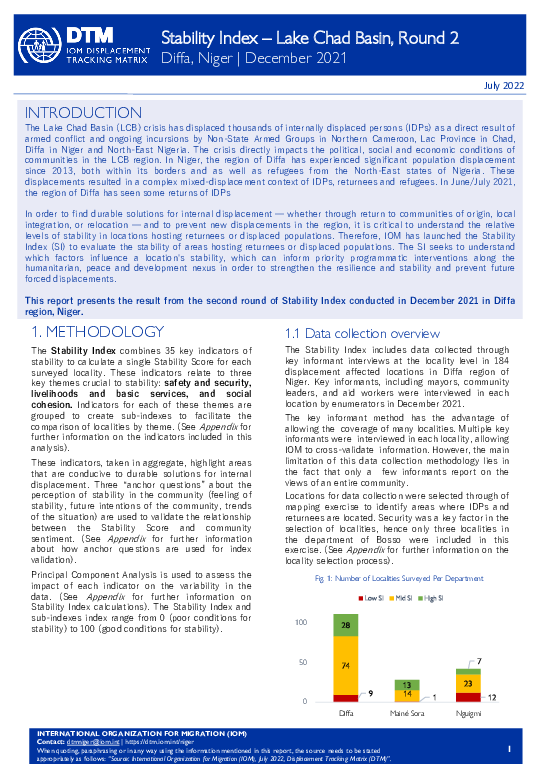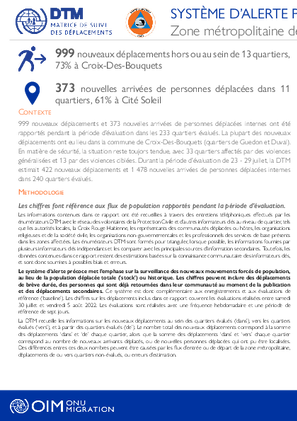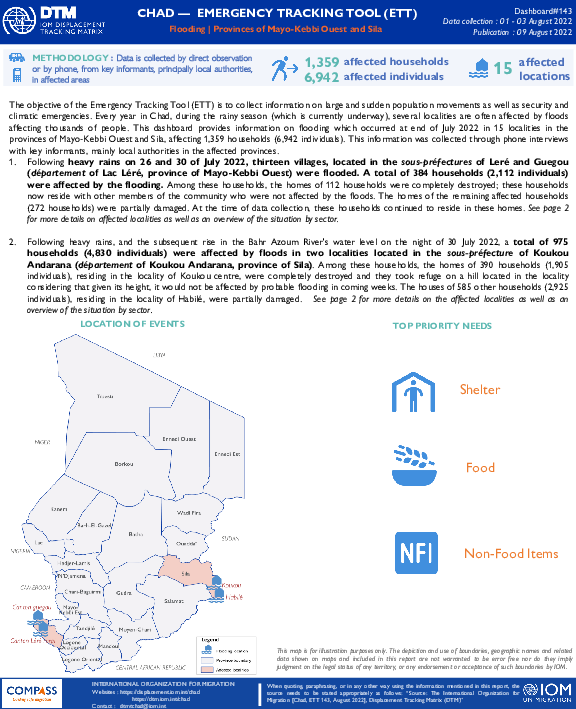-
Countries
-
Data and Analysis
-
Special Focus
-
Crisis Responses
La République centrafricaine (RCA) a été témoin de volatilité incessante depuis deux décennies. La dernière crise atteignant le pays a débuté en 2012, suite à une prise du pouvoir accouchée dans la violence, et a depuis évolué en un état d’insécurité et de fragilité permanentes, découlant d’une crise complexe de long-terme qui s’est étendue dans les pays voisins. La crise a conduit au décès de 506 personnes en 2022 (au 30 avril) et a déclenché des déplacements massifs de populations dans les sept pays touches par la crise. Cette dernière est caractérisée par des rivalités pour le pouvoir parmi les élites du pays, l’absence d’institutions étatiques et d’investissement d’argent public, des tensions inter-ethniques et inter-religieuses et la lutte pour le contrôle de ressources.
Au 31 juillet 2022, 3 314 671 individus étaient déplacés, dont 610 265 Personnes déplacées internes (18% de la population déplacées), 1 588 289 Retournées (anciennes PDI) (48%), 377 287 Retournés de l’étranger (11%) et 738 820 Réfugiés dans les pays limitrophes (22%). En RCA, les Retournés anciennes PDI représentent la plus grande population affectée (62%), tandis que les PDI représentent 24 pour cent de la population atteinte dans le pays et les Retournés de l’étranger 15 pour cent de la population déplacée présente dans le pays. Les réfugiés centrafricains résident principalement au Cameroun (347 575 individus, soit 47% des réfugiés), la République démocratique du Congo (207 118 individus, soit 28% des réfugiés) et au Tchad (124 488 individus, soit 17% des réfugiés).
The Central African Republic, which has experienced continuous volatility for the past two decades, has been riddled by a crisis which ignited in 2012 with a violent takeover of power and has developed into a complex protracted state of permanent insecurity and fragility which has spilled over into neighbouring countries. The crisis has led to the death of an estimated 506 people in 2022 (as of 30 April) and triggered significant displacement of populations in the seven affected countries. The crisis is characterized by power struggles amongst elites, the absence of state institutions and public investment, religious and ethnic tensions and disputes for the control of key resources.
As of 31 July 2022, 3,314,671 individuals were displaced, including 610,265 Internally Displaced Persons (18% of the displaced population), 1,588,289 Returnees (former IDPs) (48%), 377,297 Returnees from abroad (11%) and 738,820 Refugees in neighbouring countries (22%). In the Central African Republic, the largest displaced population consists of Former IDP Returnees (62%), while IDPs represent 24 per cent of the displaced population present in the country and Returnees from abroad represent 15 per cent of in-country displaced people. Refugees from the Central African Republic are primarily hosted by Cameroon (347,575 individuals, or 47% of refugees), the Democratic Republic of the Congo (207,118 individuals, or 28% of refugees) and Chad (124,488 individuals, or 17% of refugees).
Aug 10 2022
Print
Countries in this response
- Active DTM operation
- Past DTM operation

Contact
Niger Migration Data and Research Unit- nigerdataresearch@iom.int
Language
English
Location
Niger
Period Covered
Dec 01 2022
Dec 31 2022
Activity
- Survey
- Mobility Tracking
The instability in the region of Diffa has triggered significant internal displacement of communities in the country of Niger. This complex crisis is fueled by multiple interrelated risk factors, including growing competition over scarce resources, climate change, poverty, lack of livelihood opportunities, communal tensions, demographic pressures, and violence related to organized crime and Non-State Armed Groups.
In order to find durable solutions for internal displacement — whether through return to communities of origin, local integration, or relocation — and to prevent new displacements in the region, it is critical to understand the relative levels of stability in locations hosting returnees or displaced populations. Therefore, IOM has launched the Stability Index (SI) to evaluate and seek to understand which factors influence a location's stability, which can inform priority programmatic interventions along the humanitarian, peace and development nexus in order to strengthen the resilience and stability and prevent future forced displacements. This report presents the results of Stability Index assessments in the Diffa region of Niger.
The instability in the Liptako Gourma region of the Central Sahel has triggered significant displacement in communities in the three bordering countries: Burkina Faso, Mali, and Niger. This complex crisis is fueled by multiple interrelated risk factors, including growing competition over scarce resources, climate change, poverty, lack of livelihood opportunities, communal tensions, demographic pressures, and violence related to organized crime and Non-State Armed Groups. It has led to the death of an estimated 5,000 people in 2022 and has triggered the displacement of more than 2 million individuals throughout the affected countries. However, even as humanitarian and development needs continue to escalate, there is evidence that some displaced persons are returning to their areas of origin or habitual residence, while others face prolonged displacement, including individuals displaced in Northern Mali that left their areas of origin more than a decade ago in 2012.
In order to find durable solutions for internal displacement — whether through return to communities of origin, local integration, or relocation — and to prevent new displacements in the region, it is critical to understand the relative levels of stability in locations hosting returnees or displaced populations. Therefore, IOM has launched the Stability Index (SI) to evaluate and seek to understand which factors influence a location's stability, which can inform priority programmatic interventions along the humanitarian, peace and development nexus in order to strengthen the resilience and stability and prevent future forced displacements. This report presents the results of Stability Index assessments in Niger.

Contact
dtmhaiti@iom.int
Language
English
Location
Haiti
Period Covered
Jul 30 2022
Aug 05 2022
Activity
- Event Tracking
999 nouveaux déplacements et 373 nouvelles arrivées de personnes déplacées internes ont été rapportés pendant la période d’évaluation dans les 233 quartiers évalués. La plupart des nouveuax déplacements ont eu lieu dans la commune de Croix-Des-Bouquets (quartiers de Guedon et Duval). En matière de sécurité, la situation reste toujors tendue, avec 33 quartiers affectés par des violences généralisées et 13 par des violences ciblées. Durant la période d’évaluation de 23 - 29 juillet, la DTM estimait 422 nouveaux déplacements et 1 478 nouvelles arrivées de personnes déplacées internes dans 240 quartiers évalués.

Contact
DTM Nigeria, AllUsersInDTMNigeria@iom.int
Language
English
Location
Nigeria
Period Covered
Jul 17 2022
Aug 01 2022
Activity
- Mobility Tracking
- Event Tracking
With the onset of the rainy season in Nigeria’s northeastern state of Yobe, varying degrees of damages have been reported in camps, camp-like settings and host communities. Heavy rainfalls, accompanied by strong winds have caused serious damages to IDP shelters and camp infrastructures.
Between 17 July and 01 August 2022, IOM’s DTM programme carried out assessments to ascertain the level of damage sustained in IDP sites due to heavy windstorms and rainfall. Overall, 9 host community locations and 1 camp in Machina, Bade, Bursari, Geidam, Gujba and Gulani LGAs were assessed. The worst-hit of the assessed sites was Kukawa, a host community in Bularafa ward of Gulani LGA, where a heavy rainstorm damaged 138 shelters, affecting an estimated 1,152 individuals.

Contact
DTM Nigeria, AllUsersInDTMNigeria@iom.int
Language
English
Location
Nigeria
Period Covered
Aug 02 2022
Aug 07 2022
Activity
- Mobility Tracking
- Event Tracking
With the onset of the rainy season in Nigeria’s northeastern state of Yobe, varying degrees of damages have been reported in camps, camp-like settings and host communities. Heavy rainfalls, accompanied by strong winds have caused serious damages to IDP shelters and camp infrastructures.
Between 02 and 07 August 2022, IOM’s DTM programme carried out assessments to ascertain the level of damage sustained in IDP sites due to heavy windstorms and rainfall. Overall, 13 host community locations in Damaturu, Potiskum, Bursari, Karasawa, Gujba, Yusufari and Geidam LGAs were assessed. The worst-hit of the assessed sites was Anguwar Area, a host community in Asheikri ward of Geidam LGA, where a heavy rainstorm with floods damaged 78 shelters, affecting an estimated 507 individuals.

Contact
DTM Nigeria, AllUsersInDTMNigeria@iom.int
Language
English
Location
Nigeria
Period Covered
Mar 30 2022
Jul 08 2022
Activity
- Mobility Tracking
- Baseline Assessment
IOM’s Displacement Tracking Matrix (DTM) provides support to the Government and humanitarian partners by establishing a comprehensive system that collects, analyses and disseminates data on IDPs and returnees to ensure timely and effective assistance to the affected populations. Data collection takes place at a granular level and is repeated at regular intervals to ensure accurate and up-to-date information.
As of July 2022, the DTM identified a total of 2,455,190 IDPs in 501,758 households and 1,983,130 returnees in 323,277 households. The IDP population included IDPs in camps and camp-like settings (988,428 individuals or 40%) and IDPs residing in host communities (1,466,762 individuals or 60%). The returnee population included IDP returnees (1,822,932 individuals or 92%) and returnees from abroad (323,277 individuals or 8%).

Contact
DTM Chad, dtmtchad@iom.int
Language
English
Location
Chad
Period Covered
Jul 26 2022
Jul 30 2022
Activity
- Mobility Tracking
- Event Tracking
The objective of the Emergency Tracking Tool (ETT) is to collect information on large and sudden population movements as well as security and climatic emergencies. Every year in Chad, during the rainy season (which is currently underway), several localities are often affected by floods affecting thousands of people.
This dashboard provides information on flooding which occurred at end of July 2022 in 15 localities in the provinces of Mayo-Kebbi Ouest and Sila, affecting 1,359 households (6,942 individuals). This information was collected through phone interviews with key informants, mainly local authorities in the affected provinces.



